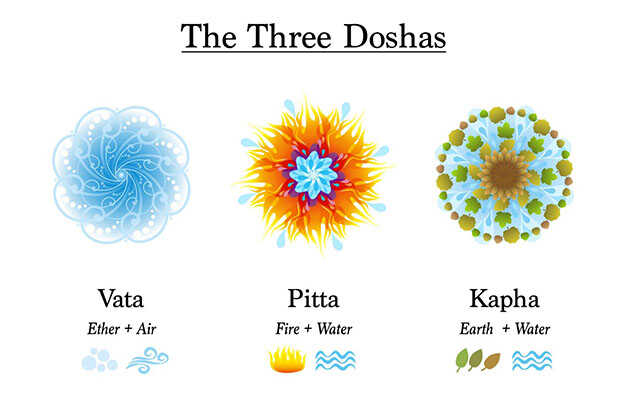In Ayurveda, an ancient system of medicine from India, focuses on treating diseases from their root cause rather than just alleviating symptoms. This holistic approach has been practiced for over 2000 to 5000 years, emphasizing the balance of energies within the body to maintain optimal health.
According to Ayurveda, every individual possesses a unique life energy that supports their physical and mental well-being. This energy is categorized into three fundamental biological forces, known as Doshas—Vata, Pitta, and Kapha. These Doshas originate from the five essential elements, or Pancha Bhuta—Earth, Water, Fire, Air, and Ether (Sky).
Each Dosha has its characteristics and plays a crucial role in bodily functions. While some individuals may have a balanced state of all three Doshas, others may experience an imbalance where one or more Doshas exceed or fall below their normal levels. Such imbalances, influenced by diet, lifestyle, and environmental factors, can lead to various health issues.
Interestingly, Ayurveda suggests that true health is achieved when a person’s Doshas remain in the same proportion as they were at his or her birth time . By understanding these Doshas and how they influence the body and mind, one can adopt Ayurvedic approach to restore balance, enhance vitality, and prevent diseases naturally.
Read More - (How to Identify Vata, Pitta, and Kapha)
- What are Vata, Pitta, and Kapha Doshas?
- How to Identify Your Prakriti (Vata, Pitta, Kapha Nature)?
- Conclusion
What are Vata, Pitta, and Kapha Doshas?
In Ayurveda, our body is believed to be balanced by three types of natural energies called Vata, Pitta, and Kapha. These energies, also known as doshas, which influence our body type, personality, and overall health. They are formed from five basic elements—earth, air, water, space, and fire—and are constantly changing based on our diet, lifestyle, and even thoughts. When these doshas are balanced, we remain healthy; when they go out of balance, we may face health issues.
Read More - (Vata Dosha Diet: Foods to Embrace and Avoid)
What is Vata Dosha?
Vata is associated with the qualities of air—light, dry, cool, and mobile. It plays a key role in body movement, blood circulation, digestion, breathing, and even brain function. It is primarily found in the joints, large intestine, ears, bones, and lower back. The brain and spinal cord also have a high amount of Vata. It also regulates the secretion of hormones and neurotransmitters that help the brain function properly.
Types of Vata Dosha and Their Roles
- Udana – Controls breathing, speech, energy levels, and mental clarity.
- Samana – Helps in digestion and absorption of food.
- Apana – Regulates urination, bowel movements, menstruation, and childbirth.
- Prana – Governs brain activity and vital life functions.
- Vyana – Controls muscle movement, blood circulation, and sweating.
What Causes Vata Imbalance?
Several factors can disturb the balance of Vata in the body, such as:
- Eating too much dry, spicy, bitter, or cold food
- Skipping meals or irregular eating habits
- Excessive physical activity or stress
- Lack of sleep
- Suppressing natural urges (like holding urine or stool)
Signs of Vata Imbalance
When Vata goes out of balance, it can lead to:
- Dry, rough skin
- Joint pain or stiffness
- Weak bones
- Muscle cramps or spasms
- Nervousness, anxiety, or restlessness
- Constipation or bloating
If you often feel cold, restless, or experience irregular digestion, your Vata dosha might be high. Ayurveda suggests warm, nourishing foods, oil massages, and a stable routine to bring Vata back into balance.
Read More - (Understanding the Ayurvedic Diet)
What is Pitta Dosha?
Pitta represents heat, energy, sharpness, and metabolism. It is responsible for digestion, hormone regulation, and body temperature control. Pitta mainly resides in the liver, heart, skin, stomach, pancreas, and spleen. It helps regulate thirst, metabolism, intelligence, vision, and mental clarity.
Types of Pitta and Their Functions
- Sadhaka Pitta – Found in the heart, it controls emotions, body temperature, and mental sharpness.
- Bhrajaka Pitta – Located in the skin, it maintains skin health and regulates body moisture.
- Pachaka Pitta – Present in the stomach and intestines, it helps digest food and produce digestive enzymes.
- Alochaka Pitta – Located in the eyes, it plays a role in vision.
- Ranjaka Pitta – Found in the liver, stomach, pancreas, and spleen, it supports digestion and blood cell formation.
Causes of Pitta Imbalance
Eating too much spicy, salty, or hot food, excessive stress, and exposure to extreme heat can disturb Pitta balance, affecting digestion and metabolism.
Symptoms of Pitta Imbalance
- Sour or pungent taste in the mouth
- Excessive sweating and body heat
- Redness or inflammation on the skin
- Burning sensation in the stomach
- Sensitivity to bright light
Read More - (What is Vamana Karma? Benefits)
What is Kapha Dosha?
Kapha represents coolness, moisture, stability, and heaviness. It is responsible for joint lubrication, body strength, immunity, and energy storage. Kapha is mainly found in the chest, joints, tongue, brain, and synovial fluid. It helps in maintaining body hydration and balance.
Types of Kapha and Their Functions
- Tarpaka Kapha – Located in the brain, it supports mental stability and sensory functions.
- Kledaka Kapha – Found in the stomach, it moistens food and protects the digestive tract.
- Avalambhaka Kapha – Located in the chest, it provides moisture and supports heart and lung function.
- Sleshaka Kapha – Present in the joints, it lubricates them and prevents friction.
- Bodhaka Kapha – Found in the tongue, it helps in the secretion of saliva for digestion.
Causes of Kapha Imbalance
Consuming too much oily or heavy food, excessive sleep, lack of physical activity, and cold weather can increase Kapha levels, leading to sluggishness.
Symptoms of Kapha Imbalance
- Weak digestion
- Pale skin
- Feeling heavy or lethargic
- Slow recovery from illnesses
- Excess mucus production
Read More - (Jal Neti and Its Benefits)
How to Identify Your Prakriti (Vata, Pitta, Kapha Nature)?
Every person has a unique prakriti based on the balance of doshas. Some people may have one dominant dosha, while others may have a combination of two.
Signs of Vata Prakriti
- Physical Traits: Slim build, dry skin and hair, small or uneven facial features.
- Mental Traits: Creative, quick thinker, but prone to anxiety and nervousness.
- Imbalance Effects: Increased stress, restlessness, digestive issues.
Signs of Pitta Prakriti
- Physical Traits: Medium build, warm body temperature, sensitive skin.
- Mental Traits: Intelligent, sharp-minded, but prone to anger and irritability.
- Imbalance Effects: Acid reflux, skin rashes, excessive sweating.
Signs of Kapha Prakriti
- Physical Traits: Strong build, smooth skin, steady energy levels.
- Mental Traits: Calm, patient, but prone to laziness or weight gain.
- Imbalance Effects: Sluggish digestion, respiratory issues, lethargy.
Read More - (Swedana Karma)
Conclusion
According to Ayurveda, there are three major doshas in the body – Vata, Pitta and Kapha, which govern the body’s natural balancing system. These doshas affect a person’s physical and mental health. Maintaining the balance of these three doshas is essential for good health, which can be cured by proper diet, routine and yoga.
Find Ayurvedic Doctor in cities
Doctors for Vata, Pitta, Kapha: Find Out Your Dominant Dosha

Dr. Ayush Bansal
Ayurveda
2 Years of Experience

Dr. Megha Sugandh
Ayurveda
6 Years of Experience

Dr. Nadeem
Ayurveda
3 Years of Experience




















